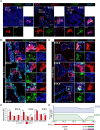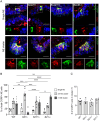Distinct roles for SOX2 and SOX21 in differentiation, distribution and maturation of pulmonary neuroendocrine cells
- PMID: 36867267
- PMCID: PMC9984344
- DOI: 10.1007/s00018-023-04731-w
Distinct roles for SOX2 and SOX21 in differentiation, distribution and maturation of pulmonary neuroendocrine cells
Abstract
Pulmonary neuroendocrine (NE) cells represent a small population in the airway epithelium, but despite this, hyperplasia of NE cells is associated with several lung diseases, such as congenital diaphragmatic hernia and bronchopulmonary dysplasia. The molecular mechanisms causing the development of NE cell hyperplasia remains poorly understood. Previously, we showed that the SOX21 modulates the SOX2-initiated differentiation of epithelial cells in the airways. Here, we show that precursor NE cells start to develop in the SOX2 + SOX21 + airway region and that SOX21 suppresses the differentiation of airway progenitors to precursor NE cells. During development, clusters of NE cells start to form and NE cells mature by expressing neuropeptide proteins, such as CGRP. Deficiency in SOX2 resulted in decreased clustering, while deficiency in SOX21 increased both the numbers of NE ASCL1 + precursor cells early in development, and the number of mature cell clusters at E18.5. In addition, at the end of gestation (E18.5), a number of NE cells in Sox2 heterozygous mice, did not yet express CGRP suggesting a delay in maturation. In conclusion, SOX2 and SOX21 function in the initiation, migration and maturation of NE cells.
Keywords: Lung development; Neuroendocrine cells; SOX2; SOX21.
© 2023. The Author(s).
Conflict of interest statement
All authors declare to have no competing financial and/or non-financial interests in relation to the work described.
Figures





Similar articles
-
SOX2 and SOX21 in Lung Epithelial Differentiation and Repair.Int J Mol Sci. 2022 Oct 27;23(21):13064. doi: 10.3390/ijms232113064. Int J Mol Sci. 2022. PMID: 36361852 Free PMC article. Review.
-
SOX21 modulates SOX2-initiated differentiation of epithelial cells in the extrapulmonary airways.Elife. 2021 Jul 21;10:e57325. doi: 10.7554/eLife.57325. Elife. 2021. PMID: 34286693 Free PMC article.
-
Sox21 inhibits glioma progression in vivo by forming complexes with Sox2 and stimulating aberrant differentiation.Int J Cancer. 2013 Sep 15;133(6):1345-56. doi: 10.1002/ijc.28147. Epub 2013 Apr 4. Int J Cancer. 2013. PMID: 23463365
-
Artificial induction of Sox21 regulates sensory cell formation in the embryonic chicken inner ear.PLoS One. 2012;7(10):e46387. doi: 10.1371/journal.pone.0046387. Epub 2012 Oct 10. PLoS One. 2012. PMID: 23071561 Free PMC article.
-
Craniofacial Development Is Fine-Tuned by Sox2.Genes (Basel). 2023 Jan 31;14(2):380. doi: 10.3390/genes14020380. Genes (Basel). 2023. PMID: 36833308 Free PMC article. Review.
Cited by
-
SOX2 and SOX21 in Lung Epithelial Differentiation and Repair.Int J Mol Sci. 2022 Oct 27;23(21):13064. doi: 10.3390/ijms232113064. Int J Mol Sci. 2022. PMID: 36361852 Free PMC article. Review.
-
Reinitiating lung development: a novel approach in the management of bronchopulmonary dysplasia.Respir Res. 2024 Oct 24;25(1):384. doi: 10.1186/s12931-024-02996-8. Respir Res. 2024. PMID: 39449014 Free PMC article. Review.
-
Descriptive and Functional Genomics in Neonatal Respiratory Distress Syndrome: From Lung Development to Targeted Therapies.Int J Mol Sci. 2024 Jan 4;25(1):649. doi: 10.3390/ijms25010649. Int J Mol Sci. 2024. PMID: 38203821 Free PMC article. Review.
References
MeSH terms
Substances
Grants and funding
LinkOut - more resources
Full Text Sources
Molecular Biology Databases
Research Materials

